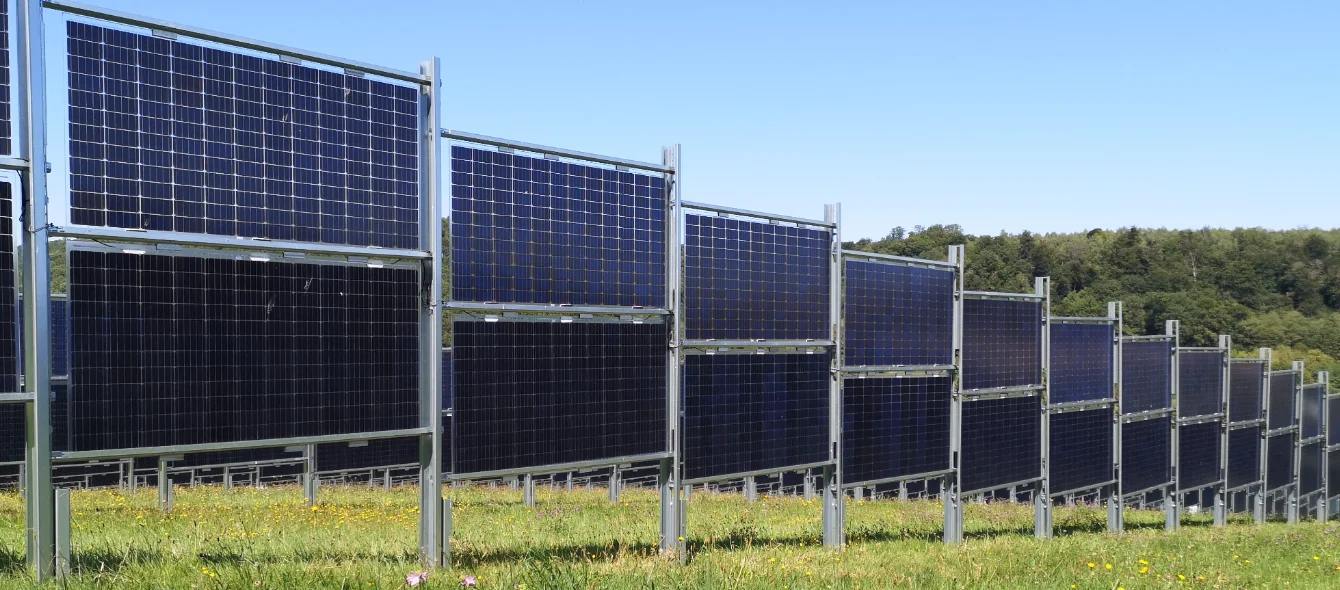Solar power production costs have hit an all-time low, as stated by the International Energy Agency (IEA) in its latest World Energy Report. What’s more, solar modules can be used in myriad ways, making them attractive for many applications. They can already be found on rooftops, fields and lakes. And engineers are constantly working on new approaches. A new series by en:former will present innovative projects in this area.
A tractor slowly moves across a field with its mower deployed in the town of Donaueschingen in the state of Baden-Württemberg. With utmost precision, it manoeuvres between two long rows of perpendicular metal stands while cutting the grass up to a few centimetres from the rods planted in the earth. Attached to the metal poles are rectangular modules with a glass face, stacked in pairs.
The 14 hectare field is the first to be used to produce electricity not just for agriculture, but also commercially. This involves a new technique from German PV provider Next2Sun which mounted some 11,000 solar modules to 5,800 stands arranged in rows. Unlike conventional arrays, these PV panels stand on end and thus use very little space. Furthermore, they are made of bifacial solar cells capable of generating electricity on both their front and back sides.
Electricity for 1,400 homes
“A very innovative solution was deployed to compensate for the lack of space in the Donaueschingen-Aasen solar farm, involving the marriage of agriculture and solar power,” declared Winfried Kretschmann, Prime Minister of Baden-Württemberg, at the opening ceremony for the largest agri-PV system using Next2Sun’s innovative stand system to date.
With a peak capacity of 4.1 megawatts (MWp) the system produces enough green electricity to meet the needs of about 1,400 homes. More than 90 percent of the field remains available for arable farming between the modules. The narrow strips beneath them provide enough room for flowering plants, which upgrade the agricultural land.
Besides overcoming the lack of space, if the farmers own the land, the solution provides them with lease payments as long as their field is used by the solar farm. Such leasehold agreements usually run for 30 years. The area in Donaueschingen is distributed among several owners, including a handful of farmers, who can continue to work their land.
Higher yields at higher prices
However, these systems cost investors a pretty penny. Bifacial solar modules are currently more expensive than the conventional variants, which face south. PV cells that can only harness energy on one side cost approximately 500 euros per kilowatt (kW) compared to 600 euros for their bifacial counterparts. In exchange, the latter promise higher yields, which experts believe can translate to as much as 15 percent more electricity. In the summer of 2020, the company received a solar award from the European Association for Renewable Energy (Eurosolar) and EnergieAgentur.NRW. “We believe agri-PV will be key to the success of Germany’s energy transition,” says Managing Director Sascha Krause-Tünker. Back in 2018, Next2Sun set up a 2 MWp pilot plant in Eppelborn’s Dirmingen district in the state of Saarland and tested the concept.
Further projects planned
According to Christian Mayer, project engineer at Next2Sun, this German innovation meets with keen interest both at home and abroad: “We have numerous projects in the pipeline,” he announces. In addition to a host of inquiries throughout the country, cooperative ventures are already underway in Austria, Switzerland, Poland and France, with more set to follow in Scandinavia, Italy and the USA. “We anticipate strong growth and are in the process of building the national and international structures for this,” the start-up’s project planner says.
Although the company claims that interested parties are lining up, bureaucratic hurdles remain to be taken. This is because, although nearly the entire area can still be farmed, the EU has stopped paying subsidies for fields with solar modules for the time being.
Moreover, Christian Mayer reports that many municiaplities still find it difficult to consider solar power systems in their land use plans. “It would require a paradigm shift in land designation, adhering to the principle of allowing for PV systems wherever they can be optimally integrated in agricultural and environmental land management,” the sustainable management expert adds.
Bildnachweis: © Next2Sun
